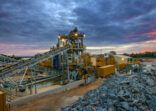Hopes of an an early resolution to the US-China trade dispute and the prospect of steady economic growth gave way to panic about a Covid-19 pandemic and the spectre of recession.
The rout in equity markets that began on 21 February and led to a 10% fall in the S&P 500 – the worst since the 2008 global financial crisis – reversed a seven-week trend of strong returns by fund sectors focused on growth and risk assets.
Until then, the average best performance of funds available to Hong Kong retail investors was achieved by products dedicated to technology, media and telecoms (TMT), generating 9.02% between 1 January and 20 February, according to FE Fundinfo. North American equity funds and infrastructure, health and property specialist products also posted healthy returns.
However, since late February fixed interest and money market funds have comprised the top performing sectors and in fact also occupy the top five positions for the year-to-date, as investors sought the safety of developed market government bonds.
Funds invested in US fixed income have enjoyed the best returns (3.24%), closely followed by the much smaller category invested in Hong Kong dollar bonds, where returns have been supported by the currency’s peg to the US dollar.
In general, the worst hit categories were emerging markets and those sectors especially vulnerable to a global economic downturn, such as energy and natural resources.
China surprise
However, there were two notable exceptions — both equity categories — at opposite ends of the performance spectrum.
Funds invested in US equities are among the five worst performers, according to FE Fundinfo, falling 15.07% on average year-to-date, as the S&P 500 led global equity markets lower.
Yet, in contrast and perhaps counter-intuitively, China funds have held up remarkably well. The top 10 performing individual funds so far this year are all invested in China, including passive products, such as the the best of them, the Mirae Asset Horizons China Cloud Computing ETF (33.28%) and the CSOP SZSE ChiNext ETF (21.99%), and active products, such as the Fullgoal China Small-Mid Cap Growth Fund (9.70%) and the Matthews China Small Companies Fund (17.14%).
As John Rekenthaler pointed out in a commentary for Morningstar on Monday, “[The] only relief came from international portfolios, as most overseas markets held up better than did the United States. Ironically, the leading category was…China region stock funds, which shed a modest 4% [during last week’s market falls]”.
In fact, some global asset managers argue that China equities could continue to do well. For instance, Invesco’s Asia-Pacific (ex-Japan) global market strategist, David Chao, wrote in a note this week that “there is light at the end of the Covid-19 tunnel in China and valuations remain compelling despite the recent rebound in China onshore equity prices”.
However, other money managers are taking a more cautious, risk-averse stance.
Pictet Wealth Management has downgraded its overall equities positioning to underweight from neutral “to take account of spreading concerns about Covid-19”, and the firm has “refrained from taking a buying opportunity until the risk of a global recession can be ruled out”, according to its March house view report.
Meanwhile, the 30% drop in the price of Brent crude oil at the weekend prompted Fidelity to note that “a worst-case scenario appears to be unfolding for oil markets. Expectations of a demand shock due to the global outbreak of the Covid-19 coronavirus collided over the weekend with an anticipated supply surge after…oil-producing nations had a major fallout over production cuts”.
In these circumstances, it is no surprise that investors turn to funds invested in high quality assets, particularly US Treasuries.
Moreover, as Rekenthaler noted, in general foreign equities are unlikely to provide diversification because “the coronavirus operates internationally”, and he adds, even more somberly, “active management hasn’t delivered on its vow to beat index funds when the going gets tough”.
Best performing sectors
| Sector |
Return: 1/01/20 – 7/03/20 |
Sector | Return: 20/02/20 – 7/03/20 | Sector |
Return: 1/01/20 – 20/02/20 |
| Fixed Interest – USD |
3.24% |
Fixed Interest -Europe | 3.37% | Equity – TMT |
9.02% |
| Fixed Interest – HKD |
3.19% |
Fixed Interest – Global | 1.75% | Equity – North America |
4.90% |
| Fixed Interest – Global |
2.52% |
Currency – non-USD | 1.67% | Equity – Infrastructure |
3.39% |
| Fixed Interest – Asia-Pacific |
1.97% |
Fixed Interest – HKD | 1.48% | Equity – Health |
3.26% |
| Fixed Interest – RMB |
1.75% |
Fixed Interest – USD | 1.46% | Equity – Property |
2.67% |
Source: FE Fundinfo. Returns in US dollars.
*20/02/20 – day before S&P 500 correction
Worst performing sectors
| Sector |
Return: 1/01/20 – 7/03/20 |
Sector | Return: 20/02/20 – 7/03/20 | Sector |
Return: 1/01/20 – 19/02/20 |
| Equity – Latin America |
-21.31% |
Equity – Latin America | -16.77% | Equity – Japan (S/M Cap) |
-6.59% |
| Equity – Energy |
-16.11% |
Equity – Emerging Europe | -15.18% | Equity – Japan |
-5.48% |
| Equity – Natural Resources |
-15.92% |
Sector – North America (S/M-Cap) | -14.90% | Equity – Latin America |
-5.54% |
| Equity – Emerging Europe |
-15.71% |
Equity – Energy | -14.55% | Equity – Single Country (Apac) |
-4.96% |
| Equity – US |
-15.07% |
Equity – Single Country (Europe) | -13.56% | Equity – Agriculture |
-3.99% |

















